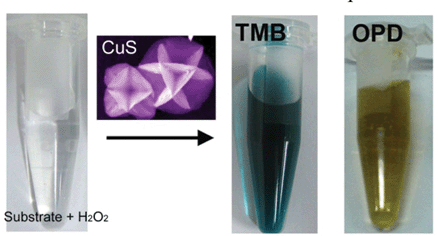Understanding the formation of CuS concave superstructures with peroxidase-like activity†
Abstract
Copper sulfide (CuS) concave polyhedral superstructures (CPSs) have been successfully prepared in an ethanolic solution by a simple solvothermal reaction without the use of surfactants or templates. Two typical well defined, high symmetry CuS concave polyhedrons, forming a concave truncated cuboctahedron and icosahedron were prepared. The effect of the reaction time, temperature and different Cu ion and sulfur sources on the formation of CuS CPSs were investigated and a possible formation mechanism was proposed and discussed based on gas chromatography–mass spectrometry. More importantly, we found, for the first time, that the CuS CPSs exhibit intrinsic peroxidase-like activity, as they can quickly catalyze the oxidation of typical horseradish peroxidase (HRP) substrates, 3,3’,5,5’-tetramethylbenzidine (TMB) and o-phenylenediamine (OPD), in the presence of hydrogen peroxide. In addition to the recent discoveries regarding peroxidase mimetics on Fe3O4 NPs and carbon nanostructures, our findings suggest a new kind of candidate for peroxidase mimics. This may open up a new application field of CuS micro–nano structures in biodetection, biocatalysis and environmental monitoring.


 Please wait while we load your content...
Please wait while we load your content...